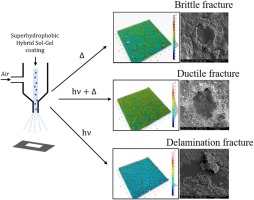当前位置:
X-MOL 学术
›
Prog. Org. Coat.
›
论文详情
Our official English website, www.x-mol.net, welcomes your
feedback! (Note: you will need to create a separate account there.)
Processing effects on the kinetics morphology and properties of hybrid sol-gel superhydrophobic coatings
Progress in Organic Coatings ( IF 6.5 ) Pub Date : 2020-03-01 , DOI: 10.1016/j.porgcoat.2019.105501 S. Czyzyk , A. Dotan , H. Dodiuk , S. Kenig
Progress in Organic Coatings ( IF 6.5 ) Pub Date : 2020-03-01 , DOI: 10.1016/j.porgcoat.2019.105501 S. Czyzyk , A. Dotan , H. Dodiuk , S. Kenig

|
Abstract Hybrid superhydrophobic sol-gel coatings were synthesized and applied on glass substrates. Low surface energy was obtained by using hydrophobic organo-functionalized silanes and roughness was formed by alkyl modified silica nanoparticles (NPs). However, these superhydrophobic coating (SHCs) are known to exhibit lack of interfacial adhesion of the NPs and limited interfacial adhesion with the underlying substrates, as demonstrated by their ease of removal in harsh environments. In this study, hybrid hydrophobic sol-gel and hydrophobic silica NPs based SHCs were prepared with the objective to obtain enhanced interfacial adhesion both between the silica NPs and the sol-gel matrix and between the sol gel matrix and glass substrates. Consequently, three curing processes were studied: Thermal, radiation, and dual curing. Dual-cured SHC presented the highest mechanical and environmental durability. It retained its superhydrophobicity (SH) for 17 tape peels and for 1000 h under accelerated weathering conditions. Failure analysis indicated that strong interfacial bonding was formed at the interface between the alkyl modified silica NPs and the hybrid hydrophobic sol gel matrix due to the interfacial free radical chemistry as well as between the sol gel coating and the glass substrate due to condensation chemistry. Moreover, the dual-cured hybrid sol-gel demonstrated transparent SHCs with over 90 % optical transmittance, water contact angle (CA) of 160˚ and a correspondingly sliding angle (SA) of ∼0˚. Morphological and roughness analyses revealed a uniform, hierarchic structure consisting of micro- and nano-sized asperities with Gaussian peak density distribution, like the Lotus leaf surface. According to ATR-IR analysis, dual curing process combines the mechanisms of chain polymerization of functional vinyl silane by radiation and thermal condensation polymerization of fluoro-silane to form a siloxane network. Hence, only chain or only condensation mechanisms lead to partial crosslinked network and low interfacial adhesion of the NPs to the sol-gel system. The dual-cured coating's failure appeared to be more ductile, compared to the brittle fracture and the delamination that were observed for thermal or radiation-cured coatings, respectively.
中文翻译:

加工对混合溶胶-凝胶超疏水涂层动力学形态和性能的影响
摘要 合成了混合超疏水溶胶-凝胶涂层并应用于玻璃基材上。通过使用疏水性有机官能化硅烷获得低表面能,并通过烷基改性二氧化硅纳米粒子 (NPs) 形成粗糙度。然而,众所周知,这些超疏水涂层 (SHC) 表现出缺乏 NP 的界面附着力,并且与下面的基材之间的界面附着力有限,正如它们在恶劣环境中易于去除所证明的那样。在这项研究中,制备了基于混合疏水溶胶-凝胶和疏水二氧化硅 NPs 的 SHC,目的是在二氧化硅 NPs 和溶胶-凝胶基质之间以及溶胶凝胶基质和玻璃基板之间获得增强的界面粘附。因此,研究了三种固化过程:热固化、辐射固化和双重固化。双固化 SHC 具有最高的机械和环境耐久性。它在 17 次胶带剥离和加速风化条件下 1000 小时保持其超疏水性 (SH)。失效分析表明,由于界面自由基化学作用,在烷基改性二氧化硅纳米颗粒和杂化疏水溶胶凝胶基质之间的界面处以及由于缩合化学作用在溶胶凝胶涂层和玻璃基板之间形成了强界面键合。此外,双重固化的混合溶胶-凝胶展示了透明的 SHC,其透光率超过 90%,水接触角 (CA) 为 160°,相应的滑动角 (SA) 为 ~0°。形态学和粗糙度分析揭示了一种均匀的分层结构,由具有高斯峰值密度分布的微米和纳米级凹凸不平组成,像荷叶面。根据 ATR-IR 分析,双重固化工艺结合了功能性乙烯基硅烷通过氟硅烷的辐射和热缩聚的链聚合机制,形成硅氧烷网络。因此,只有链或仅缩合机制会导致部分交联网络和 NPs 与溶胶-凝胶系统的低界面粘附。与分别观察到的热固化或辐射固化涂层的脆性断裂和分层相比,双重固化涂层的失效似乎更具延展性。仅链或仅缩合机制导致部分交联网络和纳米颗粒与溶胶-凝胶系统的低界面粘附。与分别观察到的热固化或辐射固化涂层的脆性断裂和分层相比,双重固化涂层的失效似乎更具延展性。仅链或仅缩合机制导致部分交联网络和纳米颗粒与溶胶-凝胶系统的低界面粘附。与分别观察到的热固化或辐射固化涂层的脆性断裂和分层相比,双重固化涂层的失效似乎更具延展性。
更新日期:2020-03-01
中文翻译:

加工对混合溶胶-凝胶超疏水涂层动力学形态和性能的影响
摘要 合成了混合超疏水溶胶-凝胶涂层并应用于玻璃基材上。通过使用疏水性有机官能化硅烷获得低表面能,并通过烷基改性二氧化硅纳米粒子 (NPs) 形成粗糙度。然而,众所周知,这些超疏水涂层 (SHC) 表现出缺乏 NP 的界面附着力,并且与下面的基材之间的界面附着力有限,正如它们在恶劣环境中易于去除所证明的那样。在这项研究中,制备了基于混合疏水溶胶-凝胶和疏水二氧化硅 NPs 的 SHC,目的是在二氧化硅 NPs 和溶胶-凝胶基质之间以及溶胶凝胶基质和玻璃基板之间获得增强的界面粘附。因此,研究了三种固化过程:热固化、辐射固化和双重固化。双固化 SHC 具有最高的机械和环境耐久性。它在 17 次胶带剥离和加速风化条件下 1000 小时保持其超疏水性 (SH)。失效分析表明,由于界面自由基化学作用,在烷基改性二氧化硅纳米颗粒和杂化疏水溶胶凝胶基质之间的界面处以及由于缩合化学作用在溶胶凝胶涂层和玻璃基板之间形成了强界面键合。此外,双重固化的混合溶胶-凝胶展示了透明的 SHC,其透光率超过 90%,水接触角 (CA) 为 160°,相应的滑动角 (SA) 为 ~0°。形态学和粗糙度分析揭示了一种均匀的分层结构,由具有高斯峰值密度分布的微米和纳米级凹凸不平组成,像荷叶面。根据 ATR-IR 分析,双重固化工艺结合了功能性乙烯基硅烷通过氟硅烷的辐射和热缩聚的链聚合机制,形成硅氧烷网络。因此,只有链或仅缩合机制会导致部分交联网络和 NPs 与溶胶-凝胶系统的低界面粘附。与分别观察到的热固化或辐射固化涂层的脆性断裂和分层相比,双重固化涂层的失效似乎更具延展性。仅链或仅缩合机制导致部分交联网络和纳米颗粒与溶胶-凝胶系统的低界面粘附。与分别观察到的热固化或辐射固化涂层的脆性断裂和分层相比,双重固化涂层的失效似乎更具延展性。仅链或仅缩合机制导致部分交联网络和纳米颗粒与溶胶-凝胶系统的低界面粘附。与分别观察到的热固化或辐射固化涂层的脆性断裂和分层相比,双重固化涂层的失效似乎更具延展性。











































 京公网安备 11010802027423号
京公网安备 11010802027423号